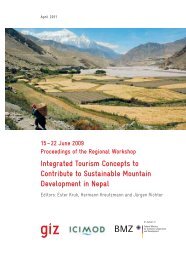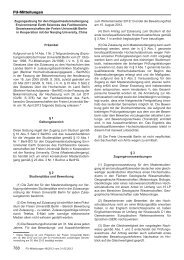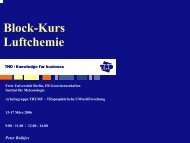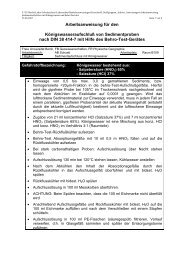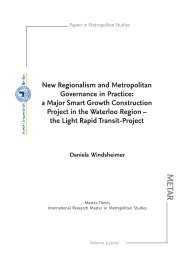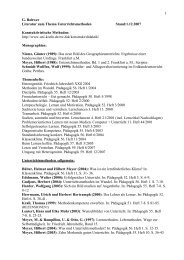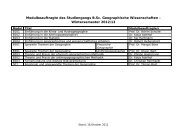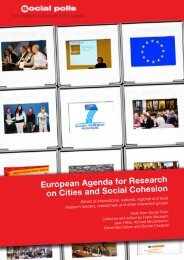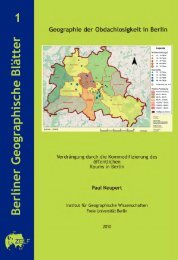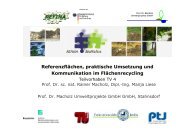After the Flood in Pakistan 38 Berlin Geographical Papers - Freie ...
After the Flood in Pakistan 38 Berlin Geographical Papers - Freie ...
After the Flood in Pakistan 38 Berlin Geographical Papers - Freie ...
Create successful ePaper yourself
Turn your PDF publications into a flip-book with our unique Google optimized e-Paper software.
facilitat<strong>in</strong>g partners for <strong>the</strong> implementation of livelihood packages provided by <strong>the</strong><br />
GRC/PRCS.<br />
Social organisation however reflects some more conservative attitudes too, as <strong>the</strong> women<br />
group <strong>in</strong> Golo Mandhro is headed by a man, <strong>the</strong> village eldest Mohammed Masroof. O<strong>the</strong>r<br />
than that most female members of <strong>the</strong> community are housewives and do not jo<strong>in</strong> public<br />
life at all. They do not work outside <strong>the</strong>ir houses, and none of <strong>the</strong> women had ever left <strong>the</strong><br />
village.<br />
80%<br />
70%<br />
60%<br />
50%<br />
40%<br />
30%<br />
20%<br />
10%<br />
0%<br />
Sheikh<br />
Kiryo<br />
Bhandari<br />
Golo<br />
Mandro<br />
Ahmed<br />
Raju<br />
Ahmed<br />
Sorjho<br />
Men and women groups both meet twice a month <strong>in</strong> order to discuss <strong>the</strong> most urgent needs<br />
of <strong>the</strong> village and develop ideas and projects for its fur<strong>the</strong>r development. In <strong>the</strong> past, <strong>the</strong><br />
proposals of <strong>the</strong> two groups have been relatively similar (hand pumps, protection measures<br />
to lower <strong>the</strong> impacts of flood events and sal<strong>in</strong>isation processes caused by oceanic<br />
processes, preparation of roads). The groups f<strong>in</strong>ance <strong>the</strong>ir work through membership fees<br />
of 10Rs per month. Fur<strong>the</strong>rmore <strong>the</strong>y have <strong>the</strong> possibility to receive funds from <strong>the</strong> PPAF<br />
(<strong>Pakistan</strong> Poverty Alleviation Fund) for projects.<br />
Overall, social cohesion among villagers seems to be very high – those with water access<br />
share it with neighbours, small credits are provided among community members without<br />
<strong>in</strong>volvement of middle-men, and self-help systems exist that enable villagers to afford and<br />
to celebrate life cycle events. However, significant challenges and constra<strong>in</strong>ts refer to <strong>the</strong><br />
health situation – most people are not vacc<strong>in</strong>ated aga<strong>in</strong>st polio and hepatitis and many<br />
cases of <strong>in</strong>cidence have been reported. Malaria represents an <strong>in</strong>creas<strong>in</strong>g problem due to<br />
<strong>the</strong> amphibious environment, and diarrhoea, sk<strong>in</strong> diseases, allergies and tuberculosis have<br />
been reported as major illnesses affect<strong>in</strong>g people <strong>in</strong> <strong>the</strong> village. Water access is still of<br />
27<br />
Alloo<br />
Noonari<br />
Wali M.<br />
Laghari<br />
Zafarabad Mehrab<br />
Qambrani<br />
Source: data recorded by ZELF team, <strong>Freie</strong> Universität Berl<strong>in</strong>, February – March 2011 n=296<br />
Fig. 5.10: Proportion of landown<strong>in</strong>g households




